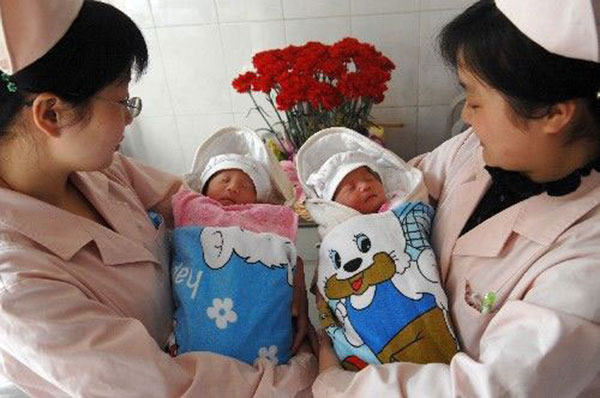Population to peak in 2025
China Daily, October 8, 2015 Adjust font size:
|
|
|
Two nurses hold baby boy and girl twins at a hospital in Hefei, Central China's Anhui province. [Photo/Xinhua] |
A lower-than-expected fertility rate means China's population will peak in 2025, something the country's leadership will have to seriously consider when drawing up its forthcoming national development blueprint, said a senior Chinese demographic expert in Brussels.
China's population is expected to peak at 1.41 billion in 2025 and the total population in 2050 will be much lower than it is today, said Zhang Juwei, director of the Institute of Population and Labor Economics at the Chinese Academy of Social Sciences.
"These projections are part of the background reports we submitted for China's leadership to consider when it designs its new national five-year plan," said Zhang, who headed a team of Chinese experts holding exchanges with their European counterparts at a two-day seminar on economic restructuring and changing employment structures in Brussels on Monday and Tuesday.
At the end of 2014, China's population was 1.37 billion. After it peaks in 2025, it is expected to decline to 1.3 billion in 2050, according to Zhang.
But China's labor supply will remain roughly stable up until 2030 despite the aging and low-fertility challenges the country faces, he added.
His team predicts that China's labor supply will range between 14.93 million and 16.98 million people every year from 2013 to 2030, with the number of graduates joining the workforce growing steadily.
"We believe that China's demographic changes, even amid the challenges, can sustain at least 10 years of medium-speed growth if we have sensible policy options," said Zhang.
China's top leaders will meet soon at a plenary session of the Communist Party of China Central Committee, at which they will discuss the upcoming 13th Five-Year Plan (2016-20) for national development.
Lin Bao, a research fellow at Zhang's institute, said at the seminar that China's family planning policy is likely to be "totally relaxed" in the face of the country's fertility and labor supply challenges.
"We have relaxed the family policy by allowing those only-child couples to give birth to a second child but, so far, this policy has not achieved the desired results. So I believe that our family planning policy will be totally relaxed soon," Lin said.
Jorg Peschner, a European Commission official said both China and the European Union face the same aging and lower fertility challenges.
"We both have to shift from the demographic dividend, which has contributed to previous economic growth, to the productivity dividend to sustain the economy," Peschner said.
Gunther Schmid, a retired professor of political economy at the Free University Berlin warned that China may get into difficulties if its development strategy is mainly based on the demographic dividend.
"But on the other hand, I think China can certainly remain competitive, mainly because young people in China are already highly qualified, which comprises China's growth strength if they are fully employed," said Schmid.
